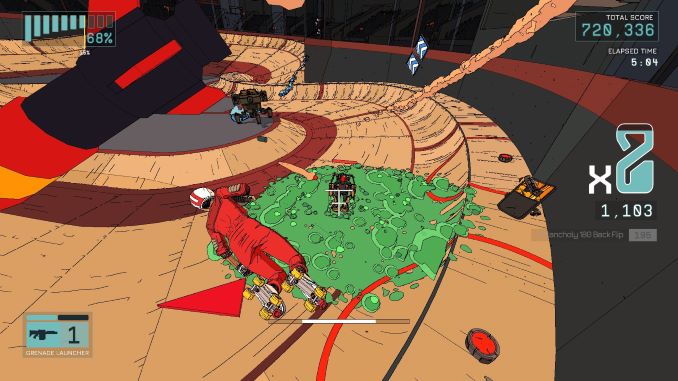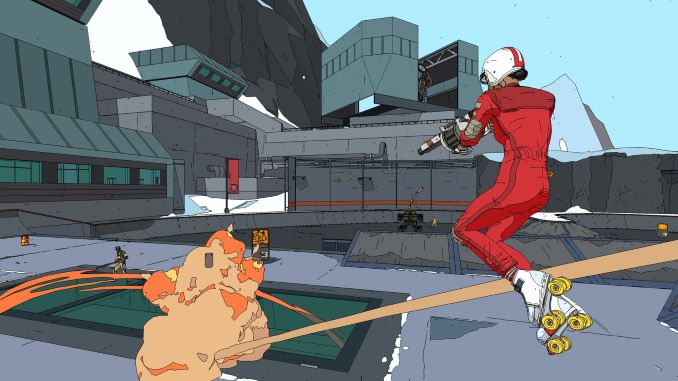It all starts with silence. Kara Hassan leaves the dressing room with a helmet and her roller skates. She marches to the other side of the tunnel where the crowd eagerly waits to see the show.
If this was a comic book, a medium to which the art style proudly pays homage, one could see a few vignettes at the start of each level. A single drop of sweat falling from Hassan’s forehead. Her hands shaking as she tries to brush away the thought that she isn’t ready. Whispers amidst the crowd—some are rooting for the rookie, others place bets on her failure.
As soon as she jumps off the ramp into the arena music breaks the silence. Bloodsports are in tonight and Hassan is the star. She’s about to prove herself once more.
Rollerdrome introduces itself with an unmatchable pitch: A skating game mixed with a third-person shooter. Roll7, the studio behind the punishing OlliOlli series, presented itself to a bigger audience (myself included) with OlliOlli World. The lo-fi vibes as well as the willingness to let the player experience the game as they see fit opened up its doors to many new players. And yet Rollerdrome stands as a hybrid of these examples. It allows the player to feel in control early on to build enough confidence while slowly introducing new mechanics and enemies. And then the rumble begins.
The structure of the game leads you through multiple stages of a championship, all the way to semis and the grand finale. Getting to a new category means you unlock a new weapon for a total of four, each with its own nature and purpose. At the same time, each level has a long list of challenges, on par with what you would expect from the OlliOlli games or the Tony Hawk series, asking you to perform specific tricks, collect items around the stage, and, of course, defeat enemies in particular ways.
During the first few levels, you’re mostly strolling around the map, learning how everything works and getting a feel for the advantages and disadvantages of each weapon. Rollerdrome is surprisingly streamlined and easy to pick up thanks to some clever design decisions. You don’t have to move forward all the time, as Hassan does it automatically after a slight bump forward. Enemies, depending on the distance, are instantly locked in when you aim down sights, making it so that you can keep on moving or perform tricks while you shoot.
The expertise of Roll7’s legacy of skating games is put on display, too, and isn’t diminished. There is a long list of basic and advanced tricks to do, and the final score at the end of each level takes into account the variety, as well as how long you managed to keep a combo going. At the same time, however, you have to dodge upcoming bullets and take down enemies. Yet the momentum isn’t split between the two. It’s integrated, making for one flow state.

There are a few mechanics in place that support and enhance that feeling. Bullet time triggers for a few seconds whenever you aim down sights or manage to make a perfect dodge right before a bullet is about to hit you. With the latter, aiming down sights immediately after gets you into a longer slow-motion period where you also deal extra damage.
Your weapons share ammunition, which means that running out of ammo in one of them leaves you unable to attack completely. But actions such as performing tricks or dodging attacks replenish those mags. As such, the synergy and motivation to always be doing tricks with the face buttons and the left analog, while immediately switching to the shoulder buttons and the right analog stick, becomes second nature. Once both genres click at your fingertips, it all feels natural.
But it’s right there when everything clicks that Rollerdrome puts you to the test, and doesn’t let up. Enemies begin to shoot you from the other side of the map, while others produce area attacks, either by throwing rockets or mines around you or literally stomping the ground. One in particular, the Polybeam, produces a long laser beam that literally follows you until either the enemy lets up or you attack them. And while the first two weapons have that auto-aim of sorts, you also unlock both a long-distance rifle and a grenade launcher, which don’t, leading you to manually aim at enemies. After you beat the game you get access to the Out for Blood mode, which presents the championship again with increased damage from enemies, as well as the presence of the harder types from the first stages.
Like many games, Rollerdrome introduces itself as beginner friendly, but then pushes the players to become better once they’ve learned the basics. We’ve seen that often this year. In Sifu, you’re bound to replay levels, as the aging mechanic puts you at a disadvantage by decreasing your health the older you get. Neon White has you replaying levels to hunt for medals in case you didn’t collect enough of them in the past. A similar case is presented here, where you need to return to previous levels and complete a number of challenges you most likely ignored the first time around.
It may seem like a way to enforce replayability, as the experience itself can be completed in a few hours (depending on your skill and patience, although there are multiple accessibility options to toggle). But it also serves to depict Kara’s efforts to make it to the finish line.
Every time you get a new weapon you’re led to revisit previous levels, making for the perfect opportunity to test things out and prepare for what’s to come. Hassan is once again going through that silent tunnel, but her confidence changes. It’s a testament to her efforts—you return to previous levels not only to tick items off the checklist, but to prove that Hassan has learned her lessons. The game itself sits on the benches with the crowd, witnessing your progress and letting you move forward once they see you succeed in the tests.
Rollerdrome excels in its premise. On one end, it’s the player that realizes that vision once they can stand, grind, and flip in that middle ground between mechanics and past influences. But the game itself is also born from taking past lessons and finding a balance, providing tools to those who want to make the experience less of a struggle, and offering a challenge to those who want to master it. And while the story itself doesn’t manage to provide much outside of some interesting yet secondary worldbuilding, witnessing the protagonist’s journey as we both manage to surpass those imposed barriers is the story that I’ll be remembering the most.
It’s fitting, then, that the championship’s final subverts the expectation of the long, silent stroll through the hall by kicking the music in as soon as you start moving forward. This time the nerves are left in the dressing room. She’s revisited her footsteps time and time again until she’s ready for the grand finale. After tonight, everyone in the crowd is going to remember Kara Hassan’s name.
Rollerdrome was developed by Roll7 and published by Private Division. Our review is based on the PC version. It is also available for PlayStation 4 and PlayStation 5.
Diego Nicolás Argüello is a freelance journalist from Argentina who has learned English thanks to videogames. You can read his work in places like Polygon, Washington Post, The Verge, and more, and he’s usually procrastinating on Twitter @diegoarguello66.

